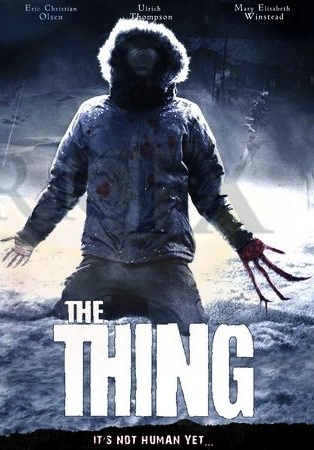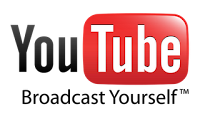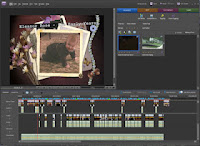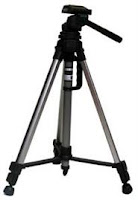1) The Title of the film
The title of the film is made using a Minion Pro font, which is effective because the lettering is bold which stands out to the audience and creates a atmospheric effect. I used black on white because it conforms with all the shots that we have already included and blends the title within the background, which adds tension. We chose Minion Pro because it was different from other titles used whilst also being still. We found through our research that the use of flowing titles and lines wasn't effective because it gives the image of emotion which is what is void in our trailer, making this more tense.
The use of a black background is effective because it leaves the audience with nothing else on the screen to attract their attention, forcing them to focus on the title. This is effective because it guarantees that the title will remain with them when watched at the end, whilst also leaving them on edge as to what is going to happen next.
Most horror films have a title which is put on a black background, one example being scream, with their own individual font which is easily recognised when audiences go to watch it in cinemas. Just like our trailer, Scream is also in white font. This is effective because the title is all the audience can look at, we found this was similar in our Prezi when researching horror films as inspiration. By taking this element we created our title, we also used the similar way in which it was placed in the middle, this way it is seen first straight which may not have happened if angled at the bottom of the screen.
This shot is made at the very end of the trailer, which is why this is one of the most important shots. By being the last shot we made it 5 seconds long, this leaves the audience to calm down over the action seen which they then want to know what happens in the film.


2) Setting/Location
We made one of the locations a large field when it was snowing, this was accidental because of the weather conditions which was when we were going to film. However, we considered that snow would make a horror trailer more atmospheric because it shows the image of being cold and out in the open, we considered making camera shots which didn't reveal the true location so that the audience felt on edge. The foot prints which we created in the snow adds atmosphere because it leaves the audience questioning who exactly has been walking in the snow and how does this effect characters which we like. We think this because the characters that we have been made to like run away from the camera straight after we see the snow, which shows us that there has been someone who has been walking on this beforehand. We made the shot darker which contrasts with the white snow so the area appears to be dark and moody, this then leads to us as an audience feeling agitated in the area because it is open and vulnerable, there is nowhere to hide.
By putting our characters in this scene it enabled us to make different shots of kill scenes and running which conforms to the horror genre. By doing this the audience see all the action shots of our characters trying to run from their killer, we included these because it makes the audience feel on edge and it shows a number of different action shots.
The film we decided to take inspiration from in the end was THE THING, a film which we had looked at through our research repeatedly at times, mainly because it was set in the snow. We found that this was effective because of the way that they used fake blood to mould into the snow, which is what we used eventually in our trailer. In their poster advertisement you can see the way that they use the snow as a way of adding tension to the audience by silhouetting a dark hooded figure. We had used this in our trailer by creating a scene where one of our characters is lying dead in the snow, and the blood was dried in. This was effective because the cold environment leaves the audience on edge and further makes them uncomfortable with the dead body that they see.


3) Costumes
The costumes we used in our trailer were effective because they didn't reveal the true identification of our characters, as seen in this clip. We connected through our research of the use of costumes that teenagers wear day to day, and used similar clothing in darker colours to make it more effective, using editing to further accentuate the killers dominance on the screen. The black clothing that our killer wore for the trailer contrasts against the white snow background making them the dominant person on the screen, this is effective because it goes against the common view that the killer hides in the background away from view, giving our trailer a unique selling point. We don't see any killings in this clip of the killer, only that they are coming close to another character in a menacing way. This connects to the theory of
Barthes Enigma Code because it leaves us questioning who the killer looks like, and is this actually the killer? These questions left unanswered make us want to see the trailer in cinemas because it has been jammed to reveal the answer to the end, when a body is found in close up on the screen.
Laura Mulvey's Male Gaze theory consists of the idea that all films are made to be in a Male characters point of view, that women are sexualised on the camera for what male audiences want to see. In our trailer this theory isn't valid because it is all based around the female characters point of view, there is only one male character in our trailer and he hardly connects to the other characters. This is effective in making our trailer unique to this theory because it goes against what audiences expect to see between a male and female character, in a horror however this is only used in a few select films because the audiences expect to see killings rather than love interests. By dressing the killer in male clothing we don't see them in a sexualised way that Laura Mulvey says that women are made to be, whilst the character being killed is also dressed from top to bottom, to keep the continuity that they are within the cold environment.
4) Props
The main prop that we used in our trailer is the knife which we chose the killer to have, this close up shows the main use of it on one of our victims neck. This is an effective choice of prop because we as an audience immediately connect the choice of weapon to a horror film, and we know as a result how this character is going to end up. This choice of prop was used halfway through the trailer to add tension, only we don't see the characters face because the killer hides it. We wanted to create this effect because it enabled us to let the audience think that they could relate to this character because they can place themselves in this characters position. Without the face to distract, it enables the audience to place themselves in this situation, making is more connecting for the audience to watch.
This conforms to the theory of Todorov's 5 stages of narrative, where he believed that all films follow this routine:
The starting order of characters within the film - in our trailers case this resolves around all the characters being connected to each other and there are no problems at this point
The order starts to be shaken - this is when events start to occur that make the audience start to realise that something is going on but we don't know as of yet. In our trailer we used camera shots to show how all our characters start running, we don't know what they are running from and what is happening. It leaves us questioning what they are running from, and what is going to happen next, however we do know that people are going to be killed because this is what the genre indicates.
The order has been broken and a character is honed on to sort out the problem through the rest of the film - We think in our trailer that Shelly is the person to sort this out, however at the end we find that she is eventually murdered, so it is unrevealed who is going to be able to sort out the order that they need to get back to. This is what draws our audience in because they want the identity of this character revealed.
Order begins to be resolved, an event takes place where the side we want to win starts to fight back - we see that some of the characters start running in different directions but we don't find out whether any begin to resolve the order, this isn't revealed because it doesn't conform to trailers. If the order is being resolved already to the audience they won't want to see it because the plot has already been given away, which means that stage 5 is also not fulfilled.
A new order has been resolved, one that is better from the beginning order - Editing at the end would be in lighter tones and with colour as opposed to black and white, to show that this is the audience that the audience are routing for. We feel connected to this main character as a result and find that this order is preferred to us than before. This is how all horror films would be resolved, including ours, making the connection to our film to this particular theory.

5) Camerawork and Editing
The use of camerawork in our horror film tends to be close ups to show emotions on our victims faces and horror connections which will draw our audience in to watch this in cinemas. We took inspiration from other horror films such as the scene below where the arm of the character is chopped off and blood is strewn across the floor. This is effective because it shows our desires to see blood and gore in cinemas up close. We tried to recreate this in our own trailer by spreading blood along the floor, and the back of her clothing, which we zoom in on in other shots. We found that this was the most received part of our trailer because of the detail that we put in to make this appear creepy, and the fact that the audience think that this is going to be the main character throughout makes us feel connected to this character and her death. We had used editing by making the tones darker, this screen grab started off with being a lighter colour with brighter tones which didn't have the same effect as this, the effects that I have made this way make this mood seem darker and more dull. The snow adds to the creepy atmosphere because it makes us feel uncomfortable for a character to be in a cold environment when murdered.


6) Title font and style
The title font was in Gothic Pro, a bold font with no added flares or flaunts which would make this appear to not be a horror film. We made these titles go against a black background because we thought that this would be effective and it connects to the title of our film. We had used different fonts for this so that the title could be seen as a separate piece of information to these titles, only for the trailer. We placed them directly in the middle because we thought it would stand out effectively against the black background and it encourages the viewer to watch this and nothing else. They were put on separately so that the entire sentence is played throughout the trailer, making the viewer anticipate the next word. Each word is connected to quick shots of our film, for example this shot was placed just before a shot of all the characters running away from the screen, this makes us feel as if we are the ones behind them, making us feel as if we are the killer. This is effective because the knife shot allowed us to feel what it was like to be a victim, while this makes us feel as if we are the killer, giving us two different points of view.

7) Story and how the trailer sets it up
The basic story of this trailer is that a group of girls are out in a public area appearing to have fun at a first glance, only for there to be quick shots of them running and being scared immediately after. This is when the audience start to realise that they are being chased by a mysterious killer and that separate events happen to them to kill them, and it is our job as the audience to find out who the killer is. The characters are seen in different camera shots such as this one, where it shows Shelly crawling away from the camera with blood stains on her back, showing that she has been wounded. This tells us the story because of the choice of make-up which is smeared on her back, only the wounds are not seen. To connect to Barthes Enigma Code, is this her blood or that of somebody else's? It makes us feel uncomfortable because of the way that the camera has been angled upwards so that we are the dominant character, maybe seeing it from the killers point of view? It is also set up that she is going to be killed which would make us feel sympathy for the character but because it is the trailer we don't know her as of yet so there is no emotional connection between the audience and her, therefore making us feel from the killers point of view, we want her to die. This is effective because of the different emotions we were trying to make in different shots, this one being the most important.

8) Genre and how the trailer suggests it
The horror genre is clearly shown in this clip of the knife being slashed on the throat, using red paint to give the illusion of blood being poured out of the gash made. This shot is without any editing effects, before I put in the black and white which made the blood look more realistic. Blood and gore is the main association with horror which is why we made sure that this was seen most of all in our trailer, but we found that the red paint didn't look realistic without the effects. By covering the face we immediately look to the blood and knife in the shot, which is effective because we wanted to make sure this stood out the most. This was followed by quick shots of Jasmine being dragged in the mud so that the blood smeared and showed the violence that we were trying to create. This is similar to our storyline because it begins to be violent in the middle of our trailer, when the killer is finally becoming revealed to the audience.
9) How characters are introduced
The characters are introduced with a 3 second long shot of the characters together in the snow, editing has been used to make the image darker. We made sure that our characters were skipping at the beginning of our trailer because it shows a more light hearted attitude to the trailer before it becomes violent to the audience. This is effective because it gives them the illusion that the trailer is going to be a different genre before the violence began. There is a scream that is heard at the end of this shot near the end which makes us start to realise the genre of our trailer, this is important because there is only one minute in our trailer which we need to include a lot of horror scenes into. Our main character appears to be shelly (purple hoody). We chose this costume for her because she then stands out to our audience as the centre of attention because the other characters are in black, but it isn't until the end that we discover that she is murdered so it is a false identification of our main character. This leaves the audience questioning who the main character is and whether she has already been introduced in this trailer shot, only dressed in black so that we don't realise. The darkening in the special effects is effective because even though it still appears to be a happy scene it gets the audience ready to see the horror that is going to happen next, this will attract more teenagers because they can relate to the character who are of the same age.

10) Special effects
We used special effects for another one of our main shots which is Abbie running in the puddle, we used black and white to keep the continuity to other shots in our trailer and appear less emotional to our audiences. These shots don't show any blood and gore which makes us question the relevance of this scene to the others in the trailer. Is there a reason why this is important to our audience?
The special effect we use is called 'ghosting' which allowed the shot to repeat itself in a ghostly like manner so she looked like she was running fast, this was effective because it gives off the creepy vibe which a horror is trying to maintain. You hear her name being shouted in the background which makes the audience wonder who is with her and what scene is happening while she is running away, is it relevant to understanding the killer in our film? What else is heard is the puddle that she runs through over the top of the music to keep the realistic continuity running through, if this was taken out if would have been less believable that she was running through.
We had taken this shot multiple times and used our best three together to add different angles so that we could see her throughout and the surroundings she was in, this is effective because it gives an audience a chance without the close ups to get a bigger understanding of what is happening in her surroundings. It then flows to close up shots of the killer with the knife slashing on the screen. This leaves the audience in suspense, we wonder whether she is the next victim or whether she escaped.
- Genre: The genre for our trailer is a horror, this is shown in our screen grabs with the use of special effects like ghosting and the camera work/ editing. These effects were created in Adobe Premier elements during our editing process, we looked at the different techniques we could find and what would work well to portray our genre. We darkened all the footage to hide the killers face, disconnecting the audience from the characters. Another aspect of our trailer that reveals the genre is the soundtrack, this is because it enhances the atmposhere creating suspence for the audience. We used a variety of camera shots and angles to build on the tension, shots such as the close-up on the knife cutting my throat creates a bigger impact on the audience, compared to if we had shot it from a distance. By having the close-up the audience can clearly see what is happening, and feel involved in what is going on. Other shots like the panning of Abbie runnning through the water is effective because the special effect and the sound of the splashing puddle at to the atmposhere, we made this shot longer to break up the rest of the fast pace action. We wanted the audience to clearly see that there is a danger that the characters are trying to escape from. When Abbie runs through the puddle we chose to show different angles of her running so that the audience didn't just see one continous shot.
- Representation: We represent the horror aspect through the use of props such as the knife and fake blood, we darkened that footage to give the overall effect of the throat cutting. If the footage had been light then the audience would be able to tell it's fake blood and that would take away from the atmposhere and it would lose the effect. We had this shot lasting about 4 seconds to highlight the killing and intrigue the audience.The teenage horror aspect was shown through the characters fear, running away and being dragged back, this clearly shows the teens fear of death. Our horror is also represented through
- Media Language: We chose to only include one word which was a characters name, this is because we wanted to leave the audience wondering what was happening in the other scenes, leaving enigma's. By only having 'Abbie's name called out this tells the audience that this character may have some importance, will she survive?, also it asks the question who was calling her name, it sounded like the person was panicking, was it a friend asking her to wait or help her? We used minimal dialogue as we wanted the music and effects to advertise our film, rather than having the dialogue reveal what is happening. By not having dialogue it intrigues the audience and leaves enigma's for them to find out.
- Audience: The target audience for our trailer was Teenagers, we addressed this through the use of our actors being teens therefore the audience can relate to them through their emotions, it takes the audience on a life journey. We aimed for the teenage audience because we wanted to create a horror that was not gory, but created suspence. We have done a questionnaire to see our audience feedback, which shows that we made the right choice for our target audience as they were intrigued by all three elements; the trailer, poster and magazine front cover.

Mise-En-Scene: We decided on having everyone dressed in normal clothes, this is because we didn't want the audience to figure out who the killer was by them having a distinct outfit. The clothing was that of typical teenagers according to the weather conditions. We had them wearing different outfits as it was a trailer and it shows that the action was happening on different days, meaning that the killer attacked them separately.


























